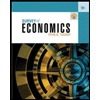How do minimum wages affect wages, employment, and unemployment? In a competitive labor market, the demand for workers is given as QD = 10,000 - 100W, and the supply of workers is given as QS = 2,000 + 1,900W, where Q is the quantity of workers employed and W is the hourly wage. What is the initial equilibrium wage and employment level? Suppose that the government decides that $5 per hour is the minimum allowable wage in any market. How would this new minimum wage alter this market? What would the new employment level be? What would happen to total payments to labor? Would there be any excess supply of labor? If so, how much?
How do minimum wages affect wages, employment, and unemployment? In a competitive labor market, the demand for workers is given as QD = 10,000 - 100W, and the supply of workers is given as QS = 2,000 + 1,900W, where Q is the quantity of workers employed and W is the hourly wage. What is the initial equilibrium wage and employment level? Suppose that the government decides that $5 per hour is the minimum allowable wage in any market. How would this new minimum wage alter this market? What would the new employment level be? What would happen to total payments to labor? Would there be any excess supply of labor? If so, how much?
Macroeconomics: Private and Public Choice (MindTap Course List)
16th Edition
ISBN:9781305506756
Author:James D. Gwartney, Richard L. Stroup, Russell S. Sobel, David A. Macpherson
Publisher:James D. Gwartney, Richard L. Stroup, Russell S. Sobel, David A. Macpherson
Chapter4: Demand And Demand: Applications And Extensions
Section: Chapter Questions
Problem 12CQ
Related questions
Question
How do minimum wages affect wages, employment, and
Expert Solution
This question has been solved!
Explore an expertly crafted, step-by-step solution for a thorough understanding of key concepts.
This is a popular solution!
Trending now
This is a popular solution!
Step by step
Solved in 6 steps

Knowledge Booster
Learn more about
Need a deep-dive on the concept behind this application? Look no further. Learn more about this topic, economics and related others by exploring similar questions and additional content below.Recommended textbooks for you

Macroeconomics: Private and Public Choice (MindTa…
Economics
ISBN:
9781305506756
Author:
James D. Gwartney, Richard L. Stroup, Russell S. Sobel, David A. Macpherson
Publisher:
Cengage Learning

Economics: Private and Public Choice (MindTap Cou…
Economics
ISBN:
9781305506725
Author:
James D. Gwartney, Richard L. Stroup, Russell S. Sobel, David A. Macpherson
Publisher:
Cengage Learning

Microeconomics: Private and Public Choice (MindTa…
Economics
ISBN:
9781305506893
Author:
James D. Gwartney, Richard L. Stroup, Russell S. Sobel, David A. Macpherson
Publisher:
Cengage Learning

Macroeconomics: Private and Public Choice (MindTa…
Economics
ISBN:
9781305506756
Author:
James D. Gwartney, Richard L. Stroup, Russell S. Sobel, David A. Macpherson
Publisher:
Cengage Learning

Economics: Private and Public Choice (MindTap Cou…
Economics
ISBN:
9781305506725
Author:
James D. Gwartney, Richard L. Stroup, Russell S. Sobel, David A. Macpherson
Publisher:
Cengage Learning

Microeconomics: Private and Public Choice (MindTa…
Economics
ISBN:
9781305506893
Author:
James D. Gwartney, Richard L. Stroup, Russell S. Sobel, David A. Macpherson
Publisher:
Cengage Learning


Survey of Economics (MindTap Course List)
Economics
ISBN:
9781305260948
Author:
Irvin B. Tucker
Publisher:
Cengage Learning
